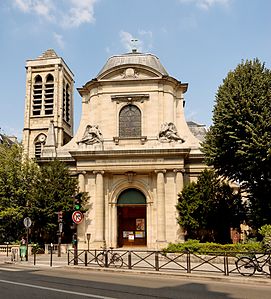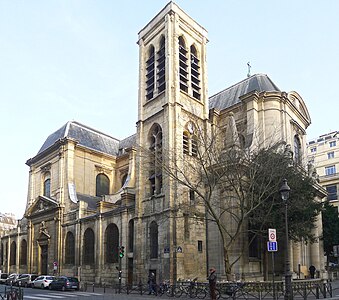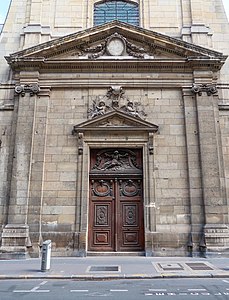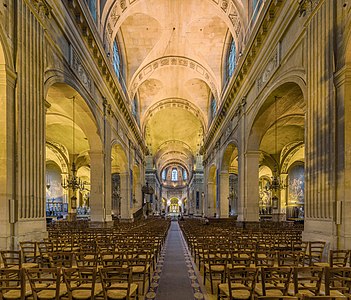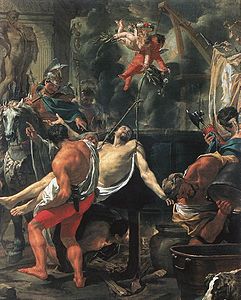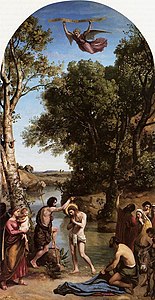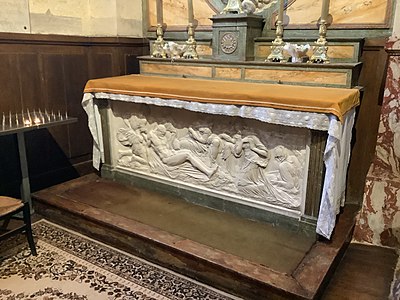Saint-Nicolas-du-Chardonnet
| Church of Saint-Nicolas du Chardonnet | |
|---|---|
Église Saint-Nicolas du Chardonnet | |
Society of St. Pius X (de facto) | |
| Clergy | |
| Priest in charge | Fr Michel Frament SSPX (since 2022) |
Saint-Nicolas du Chardonnet (French pronunciation:
Since the expulsion of the parish priest and his assistants by
History
Establishment

A chapel was first built in 1230, in a field planted with chardons (thistles), hence the name. It originally was a dependence of the
In the late 17th century, noted harpsichordist Jean-Nicolas Geoffroy (1633–1694) served as titular organist of the church.[3]
The church was closed and badly damaged during the French Revolution, and most of the art was destroyed. It was gradually replaced with new work by French artists in the 19th century.
Since 1905, the city of Paris, following the enactment of the law on separation of Church and State, claims ownership of the church but grants the Roman Catholic Church a free usage right.
1977 occupation and rededication
On 27 February 1977,
In 1978, the
Ducaud-Bourget died in 1984, and was replaced by
In April 2020, during the
Exterior
-
The west front (completed 1937), with main doorway and bell tower
-
Southwest side of the church along Rue des Bernardins
-
The apse of the church
The construction of the primary facade of the church on Rue Monge, designed by architect Charles Halley, was long unfinished, and was not completed until 1937. It follows the classical style of the rest of the building. The side doorway along the rue des Bernardins, designed by
-
Side portal on rue des Bernardins, by Charles Le Brun (1669)
-
Detail of portal on Rue des Bernardins
-
Carvings over the portal on Rue des Bernardins
Interior
-
Plan of the church
-
The nave. Note the absence of a "table" altar; Masses are celebrated with priest facing the altar (ad orientem).
-
The Altar
-
The nave and the choir
The interior of the church is a good example of the Baroque style, lavishly decorated with paintings, medallions and sculpture, dedicated to visually expressing the glory of God. The nave is lined with rows of cruciform pillars, and pilasters with capitals decorated with acanthus leaves in the classical style The arcades that separate the outer aisles from the nave have rounded arches, also in the classical Roman style.[2]
The arrangement of the interior was modified to suit pre-Vatican II liturgical arrangements after 1977 when the church was occupied by the traditionalist
Art and Decoration - the Chapels
Chapels of Lower Right Aisle - Le Brun and Corot
-
"The Martyrdom of Saint John the Evangelist at the Latin Gate" by Charles Le Brun
-
"The Baptism of Christ" byJean-Baptiste Camille Corot
The chapel in the first traverse displays an early work by Charles Le Brun, called "The Martyrdom of Saint John the Evangelist at the Latin Gate." Le Brun was a student of Simon Vouet, who later became the court painter of Louis XIV. It depicts Saint John, who has been sentenced by the Emperor Diocletian to be thrown into a vat of boiling oil, from which his body emerges unscathed. The painting displays his early skill depicting the human form and the sense of movement.[12]
The Chapel of the Baptismal Fonts displays a rare religious painting by
Sculpture in the chapels
-
Chapel of the Virgin
-
Tomb of the court painter of Louis XIV, Charles Le Brun
-
Tomb of Julienne Le Be, mother of Charles Le Brun, by Jean Collington
-
Tomb ofMichel Anguier
The central feature of the Chapel of Saint-Charles-Boromée is the funeral monument of Charles Le Brun and his wife, Suzanne Butay, made by the sculptor Antoine Coysevox (1640-1720). In the same chapel, the sculptor Jean Collignon (died 1702) created the tomb of Juilienne Le Be, the mother of Le Brun, following a drawing by Le Brun. The composition of the sculpture follows a theme typical of the French Baroque style at the beginning of the 18th century. The deceased is depicted emerging from her tomb, praying, with her eyes upward. Above her is a sculpture of an angel with a trumpet, announcing the Judgement Day and her resurrection.[13]
-
The pulpit in the nave
-
Altar in Chapel of Saint Vincent de Paul
-
Carved sculpture in the nave
Services
The priests of the SSPX at Saint-Nicolas-du-Chardonnet livestream every Mass offered at the church on YouTube, along with Vespers, clergy-led Rosaries, and catechism lessons.
References
- ^ Saint-Nicolas-du-Chardonnet Church at Structurae
- ^ a b c Dumoulin, Ardisson (2010), p. 101
- ^ "Saint-Nicolas-du-Chardonnet", The Organs of Paris
- ^ a b "Saint-Nicolas-du-Chardonnet : avec foi mais sans loi". Libération (in French). 11 May 2012. Retrieved 13 April 2020.
- ^ a b c Moreau, Theresa Maria (19 September 2017). "Celebrating Fortieth Anniversary of Takeover of Saint-Nicolas-du-Chardonnet, Paris". The Remnant. Retrieved 13 April 2020.
- ^ Hargrove, Charles (5 July 1977). "Mediator in church dispute admits defeat". The Times.
- ^ 2002 V. 83 - Vœu relatif à l'occupation de l'église Saint-Nicolas-du-Chardonnet Archived 2007-03-11 at the Wayback Machine
- ^ 183 - Vœu présenté par M. Sylvain GAREL et les membres du groupe "Les Verts" sur l'occupation de l'église Saint-Nicolas-du-Chardonnet (in French)
- ^ Les Lebevristes se déchirent, La Croix, 9 September 2004. (Archived: 7 February 2012) (in French)
- ^ "Vigile Pascale 22h30". Eglise Saint-Nicolas-du-Chardonnet YouTube Channel. 11 April 2020. Archived from the original on 2021-12-21.
- ^ Hansrod, Zeenat (13 April 2020). "Traditionalist Paris priest defies lockdown and holds Easter Vigil service". RFI. Retrieved 13 April 2020.
- ^ a b Dumoulin, Ardisson (2010), p. 102
- ^ Dumoulin, Ardisson (2010), p.103
Bibliography (in French)
- Dumoulin, Aline; Ardisson, Alexandra; Maingard, Jérôme; Antonello, Murielle; Églises de Paris (2010), Éditions Massin, Issy-Les-Moulineaux, ISBN 978-2-7072-0683-1
- Hillairet, Jacques; Connaissance du Vieux Paris; (2017); Éditions Payot-Rivages, Paris; (in French). ISBN 978-2-2289-1911-1

